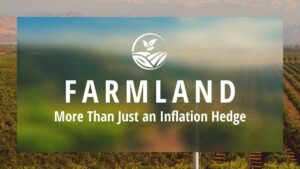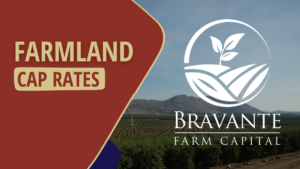From Finance to Agriculture - the Story of a Gentleman Farmer
“Soil, water, microclimate. Those are the basics of successful farming,” advises George Bravante, founder of Visalia, Ca.-based Bravante Farm Capital. “Then, lots of hard work, and applied industry knowledge. Plus, you have to buy right.”
Bravante pauses a bit, as if recalling a lesson so ingrained it is second nature, and not expressed out loud. “Oh, and proximity to services, to roads. You have to get produce to markets in a timely fashion,” he adds.
A rarity on the agri-business landscape, Bravante brings a usefully institutional real estate background to the farming trade, having first been involved in the financial and commercial property side of the industry.
Bravante grew up in New Jersey the son of mailman, and then earned an accounting degree at the University of South Carolina because “that was the cheapest university there was.”
After university, Bravante started as a foot soldier in what was then called “The Big Eight”—the largest accounting firms in the country—but his career quickly progressed. Bravante teamed up with a client, and soon began hatching property transactions with names such as Tom Barrack of Colony Capital and the Robert M. Bass Group.
When the savings and loan crisis hit the economy in the late 1980’s, and after some years in big-league property transactions, but not yet 30, Bravante was turned loose to oversee the American Real Estate Group which was the equally sized bad bank side of a failed savings & loan institution, American Savings.
The bank had failed, and regulators split it into two parts, the good and the bad, each with $20 billion of assets.
George’s assignment brought him to Stockton, California, where he was quickly appointed President of American Real Estate Group, a combination of the bad side of American Savings and New West Federal Savings and Loan.
It was another challenge and victory for Bravante, and the high-profile success story set him up to do most any sort of deal he wanted to do, in the sprawling worlds of finance and property.
“There was always that something in the back of my mind. I loved the finance business, but for me, being a ‘deal junkie’ for another 30 years was not a life,” recalls Bravante.
Bravante, then married, wanted a place to raise a family, and by chance visited Napa Valley.
The fix was in, but this time not by Bravante, but on Bravante.
"You know, it's hard not to like agriculture in Napa Valley because it's beautiful and the food is good and the climate is good and everybody's happy up there,” he explains, recalling his initial visit.
Answering the ancestral siren as well as the call of the Napa Valley lifestyle, Bravante bought 20 raw acres the same week he first visited, to set up a wine-grape growing operation, thus joining the ranks of viticulturists. “And we have stayed here ever since,” he explains.
As the decades went by, Bravante and business-partner and wife Nancy raised three sons, and multiplied their holdings 300-fold, branching into other crops as well as vertically integrating.
For all of the winnings, some career and family lessons are too deep to die: “We don't have a lot of debt. We're very under-levered on everything. So we're kind of bulletproof,” explains Bravante.
Recessions or not, the Bravantes are not going to lose the family farm, or any other business venture, in future business cycles.
Learn more about our investment strategy and join the waitlist for our next opportunity.
The Packing House
No matter the successes, some lessons stuck for the son a mailman whose ancestral family wealth—and generations of work—had been obliterated in the Great Depression.
Not only that, mid-career Bravante had assumed the operation of American Real Estate Group, the biggest turnaround of all S&L failures. Bravante knew victories but had also been first-hand witness to defeats that destroyed capital entirely.
Bravante wanted to stay in agriculture but wanted a broader base of business. He had hundreds of acres of citrus, the produce from which he then turned over to packing houses, which then boxed and shipped the produce to market and retailers.
To the lay public, packing houses are nearly invisible, but that end of the trade has moved far beyond sorting lemons and oranges into boxes.
In the modern era, packing-house operations can include washing, waxing, sorting and grading, vapor treatment, chemical treatment and much more, all connected to a cold-storage facility.
One doesn’t have to be a financial Sherlock Holmes to deduce packing houses have a steadier business than the dozens or hundreds of individual farmers they serve, and that the packing houses take a middleman’s variable cut. No farmer will get to market without first coming to terms with the packing house or working through a cooperative.
“Well, it didn’t take us long to decide to build a state-of-the-art packing house,” remembers Bravante. And so the facility was built in Reedley, Ca., in 2006 and became a core component of Bravante’s farming operations.
Owning a packing facility also gave Bravante the means to pack and ship select product to discriminating buyers. “Most packers, they are good businesspeople, but they need to pack and ship as much as they can. So many dollars per box,” explains Bravante.
To appeal to discriminating buyers, Bravante wanted peerless quality control not only on the farms but inside the packing house, and ultimately that meant owning and operating the whole process from planting to shipping.
Bravante does not see the packing house as a profit center, however, charging the farm ranches he owns and manages only at breakeven – enough to keep them operating efficiently, but while pushing all the profits down to the ranch level.
Alongside the initial foray into grapes and the packing facility, the Bravante’s have assembled almost 3,000 prime acres in citrus, as well as a few other fruits including table and wine grapes.
So, after decades in agriculture, does Bravante have regrets on leaving institutional commercial real estate investment and finance behind?
“Well, I am lucky guy in that I tend to enjoy what I do,” answers “You know, my kids would tell you, it wouldn't matter if I was selling hot dogs, I always love what I do!”
That said, the seasonal nature and innovations in agriculture provide enough variety, that the grass is perennially greener—on this side of the fence, Bravante avers.
“I like agriculture because it changes every day. And every year, you get a reset. Yes, this season we try a new crop, or a new market, or the most recent innovations in agricultural products and techniques,” observes Bravante. “The business evolves, and usually for the better.”
Investors
Perhaps inevitably, given Bravante’s acumen, experience and networks in agriculture, finance, and real estate circles, in recent years investors and dealmakers have approached Bravante to actively participate in his private-equity offerings.
Where there is a good fit, Bravante says he will work for and help run a private equity fund. “Given the experience and that of people around me, we do have a superior ability to understand what opportunities are out there,” explains Bravante. “We see some money entering the sector, and if luck holds they will make money. But farming is different. To maximize profits and limit risk takes an edge.”
Bravante co-invests with limited partners, and capital is treated equally. “The only problem is, after improving the land and the operations, and getting everything into perfect shape, I prefer not to sell,” muses Bravante. “It is like my land, and I treat it like my land. But investors often want to liquidate at seven years or 10 years. So, we do, and everyone makes money, but it is bittersweet.”
The Outlook
Beyond the pleasures of farming, Bravante says the agriculture sector appears to be the catbird seat for the 2020s. “There is a case to be made that commodity prices are headed higher, due to demand but supply constraints, and I could sell you the big upside story,” he says. “But even more than that, I see a lot of downside protection in some iffy years ahead. I can tell you this: at the end of the 2020s people will still be eating, and we will still be selling produce.”
With shrewd management, investors in farm ranches should be able get annual dividends and a good return on capital through the 2020s, with limited downside and a potentially handsome upside, states Bravante.
“The risk-reward profile in farming is very attractive. No, you likely will not have ’10-baggers’ on farming,” calculates Bravante. “But capital will be preserved and profits will be made.”



